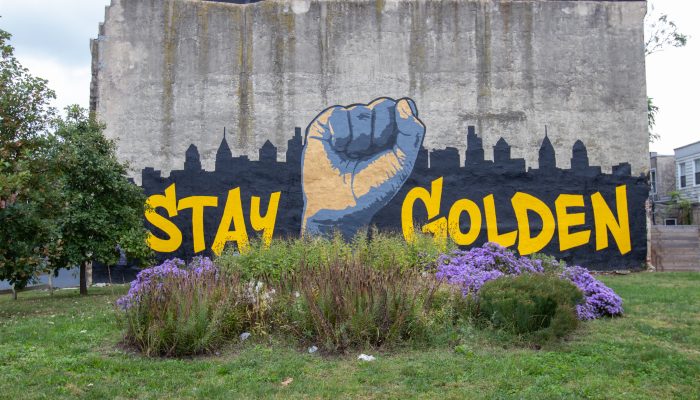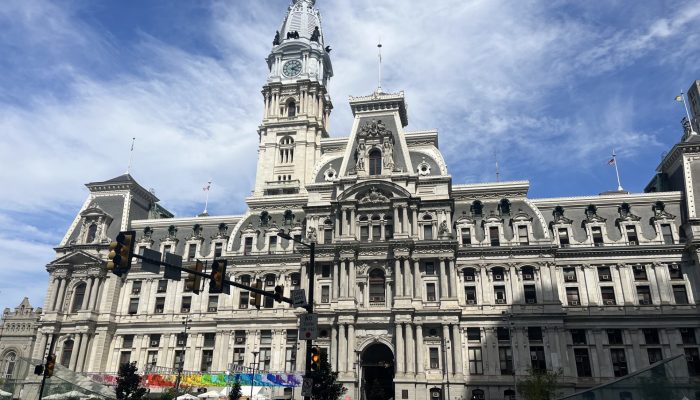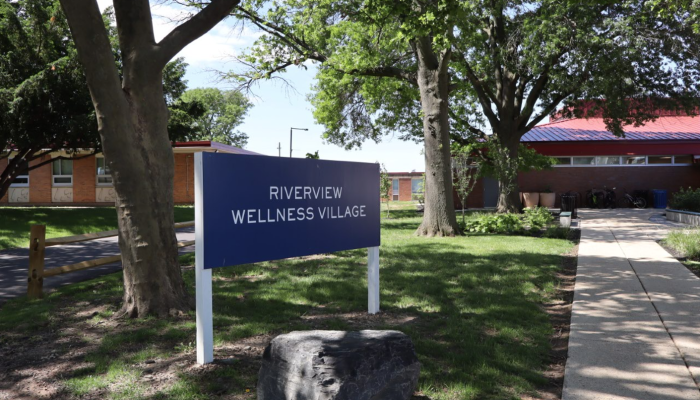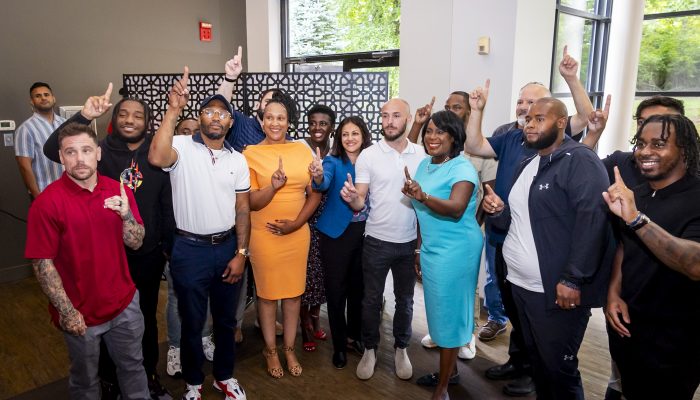Guided by the Philadelphia Roadmap to Safer Communities, Philadelphia made a historic investment in reducing gun violence in fiscal year 2022, with more than $155 million to address urgent violence prevention needs through a multi-disciplinary approach focused on community empowerment, employment and careers, healing, prevention, and safe havens for children and youth.
With the full set of violence prevention investments—including long-term investments—we’re directing more than $200 million to help make our communities safer and reduce violence.
| Spending Category | Sum of FY23 Total |
| Community empowerment | $ 20,407,435 |
| Employment and careers | $ 23,080,146 |
| Healing | $ 29,125,682 |
| Prevention | $ 108,461,824 |
| Safe havens for youth & families | $ 27,402,622 |
| Grand Total | $ 208,477,709 |
Key ways we’re combating gun violence
Over the last few years, Philadelphia has launched anti-violence models that have clear track records of reducing violence, and we will continue to evaluate the impact of these initiatives.
CCIP and GVI’s independent evaluations are anticipated for completion in early 2023. In fiscal year 2023, we look to invest an additional $575,000 in data and administrative infrastructure to improve the efficacy of these programs as they expand.
In fiscal year 2022, the City expanded the reach of programs, including:
Group Violence Intervention (GVI)
GVI has grown to six new police districts, and hosted its first group call-in. GVI reduces violence involving neighborhood groups by hosting group or one-on-one meetings (“call-ins”) that pair community members and case managers offering direct help to individuals engaged in violence with law enforcement plainly stating the consequences if violence continues. In fiscal year 2023, GVI will grow from three to 12 case managers, expand to operate in all police divisions citywide, and host a minimum of five group call-ins over the course of the year.
Community Crisis Intervention Program (CCIP)
CCIP relies on credible community messengers to respond to violence by connecting with highly at-risk individuals to reduce tensions, mediate conflicts, and help them access critical services. This fiscal year, CCIP will partner with community-based organizations to expand its footprint and have a deeper on-the-ground presence in up to four new areas.
Transitional work and training
Transitional work and training paired with wrap-around services create viable on-ramps to a career and family-sustaining wages. In addition to connecting 1,070 at-risk people to jobs and same-day work and pay in the first half of the fiscal year, the City is now set to launch the Rapid Employment and Development Initiative (READI), modeled after a successful program in Chicago that relentlessly engages those highly at-risk and connects them to therapy, paid transitional jobs, and support services.
911 Call Triage & Co-Responder
By integrating behavioral health specialists into Police responses to 911 calls, we can deescalate behavioral health crises and connect individuals to needed services. In the next fiscal year, the initiative will expand to integrate behavioral health professionals into Emergency Medical Services (EMS). In addition, the Philadelphia Crisis Line and Community Mobile Crisis Teams expansion—which grew the availability of more community-focused telephonic and in-person supports for people with critical behavioral health concerns when police intervention is not needed—is on track to serve 21 percent more individuals in this fiscal year.
Hospital-Based Violence Intervention Program (HVIP) Collaborative
The HVIP Collaborative was launched with all six of Philadelphia’s level one trauma centers and several associated partners, to improve the delivery of services to individuals at-risk and strengthen its impact. HVIP combines the efforts of hospital systems and community-based partners to provide comprehensive case management for violently injured individuals and families as soon as possible after hospitalization.
Police Assisted Diversion (PAD)
PAD expanded operations by 25 percent, adding services in the East Police Division (Kensington). PAD diverts low-level, non-violent offenders away from the criminal justice system and connects them to critical support services. In fiscal year 2023, PAD will expand into the Northeast Police Division, with a focus on the 15th Police District.
Environmental changes
In 2021 there was a 109 percent increase in vacant lots stabilized and/or maintained and a 44 percent increase in buildings demolished or cleaned and sealed in targeted areas. Environmental changes like these have been shown to help significantly reduce neighborhood crime. In FY23, vacant lot improvements will be expanded by 20 percent to reach more communities in targeted areas.
Community-focused interventions
Philadelphians who are most impacted by gun violence are often closest to the solutions. By investing in community-based programs and neighborhood-led initiatives, we can effectively and sustainably reduce violence. In fiscal year 2022, the City doubled down on our investments in community-based solutions:
- The newly created Community Expansion Grant (CEG) program provided $13,500,000 in grants— ranging from $100,000 – $1,000,000—to 31 organizations.
- Targeted Community Investment Grant (TCIG) investment was expanded by 67% to $2,500,000. 41 organizations were awarded grants totaling $900,000, and another TCIG grant cycle will open in late spring 2022.
- The Office of Victim Advocate opened in February 2022, providing coordination, strategic planning, and program oversight, and serving as a support hub for survivors, with a special emphasis on gun violence and homicide.
- The Philadelphia Violence Prevention Hotline launched in March 2022, connecting individuals and families involved in or affected by gun violence with important services. Philadelphians can now reach the hotline by dialing 2-1-1 and selecting option 3 or by texting their zip code to 898-211.
- Network of Neighbors is set to expand its work empowering communities to create safe spaces in response to trauma, and nearly double the number of individuals it supports in fiscal year 2023.
In fiscal year 2023, the City will continue to focus on community-based interventions, building on the success of the Community Expansion Grants and Targeted Community Investment Grants, investing in organizations with a track record of delivering quality, culturally-relevant services, as well as launching new community education programming.
Prevention efforts
From solutions that keep youth and young adults from entering the cycle of violence to programs that assist those who have been impacted in reducing their risk levels of repeat exposure, gun violence prevention includes a wide range of interventions aimed at reducing risks or threats to health and well-being. Among the City’s prevention investments in fiscal year 2022:
- 159 Recreation Centers were reopened in the summer of 2021 and provided weekday services, alongside 42 pools and over 94 spray grounds.
- Two new Community Evening Resource Centers (CERC) were opened that operate daily from 7 p.m. – 2 a.m. CERCs support Philadelphia youth during curfew hours and provide programs that emphasize conflict resolution, mentoring, and service linkages.
- 100 Intensive Prevention Service (IPS) program slots were added in Southwest Philly, bringing the total IPS slots to 1,300. IPS provides pre-arrest prevention activities and community engagement for youth, ages 10 – 19, who are at high risk of becoming delinquent. In FY23, IPS will launch gun violence mitigation case management to provide direct social services to youth in their program.
In fiscal year 2023, the City will continue to support key prevention programs, including summer camps, Free Library in-person programming, Out of School Time, Community Schools, and PHL Pre-K. Additionally, the City will build on these successes and expand prevention programs—like Community Evening Resource Centers and the Octavius Catto Scholarship—to reach more residents.
Modernizing police capabilities to reduce violence
The Philadelphia Police Department’s Operation Pinpoint, which identifies a small number of blocks in an area that have become violence hotspots, continues to undergird the City’s place-based approach to gun violence. It uses police intelligence and collaboration with other law enforcement partners to strategically address violence, while at the same time, leveraging environmental changes, community partnerships, and social services to address root causes.
To enhance our strategic approach to community policing, the City is making investments to modernize key aspects, including:
- The Mobility Project is expanding the use of mobile devices. This, paired with the recently launched Crime Information Centers to conduct analysis, enables camera monitoring and data analysis to provide real-time information when and where it is most needed. In the next year, this initiative will provide an additional 2,650 officers (44 percent of the force) with mobile devices and add four new divisional Crime Information Centers.
- Forensic science enhancements have enabled the analysis of evidence related to gun violence that was previously impossible, expanded capabilities to link crimes to each other and to the perpetrators. Last year, the City added two new systems to examine cellphones and other devices. In fiscal year 2023, new systems allowing for the 3D scanning and reconstruction of crime scenes and the robotic automation of DNA evidence will enable the faster analysis of evidence.
New initiatives in Fiscal Year 2023
Looking ahead to fiscal year 2023, the City will strategically focus on new investments to bolster the goals and outcomes of existing programs and address gaps in services.
In fiscal year 2023, the City will launch several new initiatives and expand other key programs, including:
- Launch the Gun Violence Prevention Program that will serve juvenile offenders who are involved in or highly at risk of becoming involved in gun violence or other violent crimes.
- Expand the restitution fund to offer more youth an opportunity to resolve outstanding restitution obligations that are barriers to closing their probation cases.
- Expand restorative justice diversion, a victim-centered diversion program in which a young person accused of harming another will undertake a process by which the young person repairs harm to the person harmed, the youth’s family/caregiver, the youth’s community, and the youth themselves.
- Expand pre- and post-adjudication evening reporting centers to provide 40 youth alternatives to secure detention and placement before and after the adjudicatory processing stage of juvenile court.
- Address a key gap in available services by investing in behavioral health supports for people highly at-risk of gun violence. This investment will reduce barriers to accessing behavioral health resources for those at the highest risk of gun violence by deepening outreach to the target population, creating new spaces for accessing treatment and covering individuals’ costs related to seeking treatment.
- Help up to 3,000 people complete Accelerated Misdemeanor Program (AMP) by paying the approximately $250 mandatory court costs for individuals who successfully complete the program. AMP is an alternative to traditional prosecution methods used in drug court that diverts offenders with low-level misdemeanor arrests to treatment services or community service.
- Expand Gun Homicide Review and launch the Non-Fatal Shooting Review. Modeled after a program in Milwaukee, these reviews bring together key stakeholders to examine the causes of particular firearm injuries and deaths within their community to find trends and key interventions. With additional resources, they can expand the scope of the review, design specific interventions needed in a given neighborhood; engage the community in the selection and implementation of action items, and elevate community-driven solutions addressing more upstream causes of violence.




